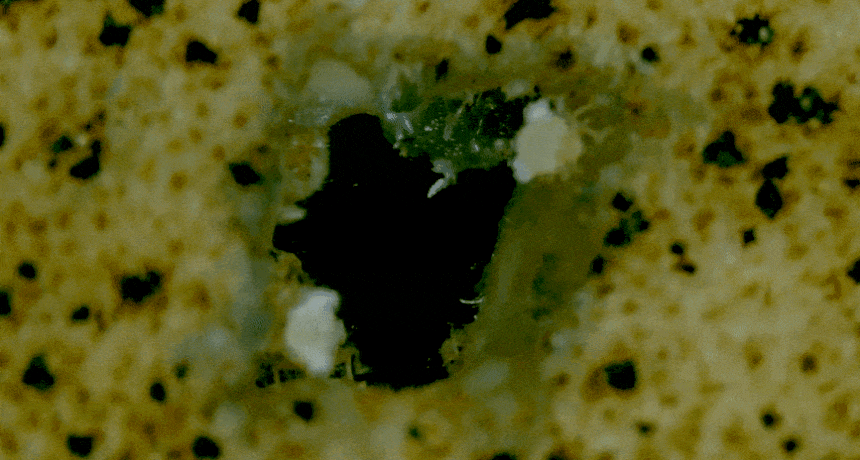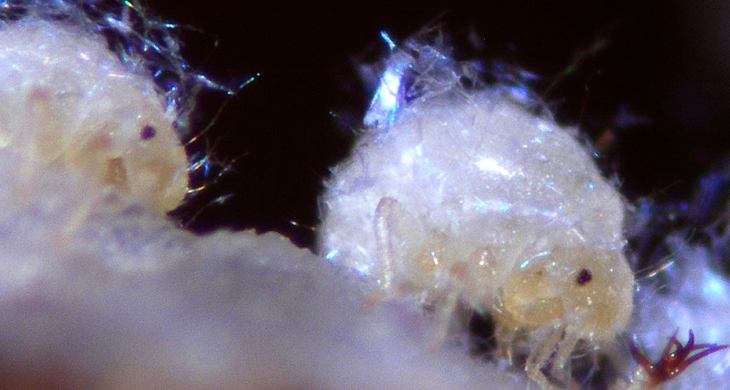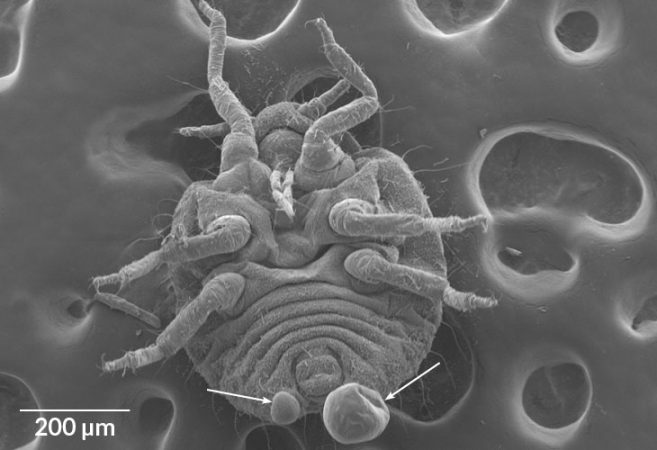Young aphids sacrifice themselves to make home repairs
Soldiers exude a white goo to patch holes in their colony’s tree-house

If a predator breaks through the wall of the gall housing these aphids, some of the tiny insects will exude a goo that will harden and plaster shut the opening. Unfortunately, the home-repair crews will likely lose their life in the process.
M. Kutsukake et al/PNAS 2019
By Susan Milius
Home renovation is never easy. Watch one of those shows on HGTV and you’ll see. But be glad you’re not a young aphid. For them, the cost of being dispatched to patch up a home can be death.
Nipponaphis monzeni is a tiny East Asian aphid. It makes its home in Asian winter hazel trees. Hundreds or thousands of the insects will share a hard-shelled, closed lump called a gall. The fragile insects induce the trees to make that gall, which will protect their colony. But sometimes a predatory caterpillar will chew into the wall to get at the aphids. At once, white wingless youngsters, called soldiers, rush to the breach.

Some mob and sting the intruder. Others get on to patching the hole. Swollen almost to bursting with fluids, these soldiers work as part repair crew, part repair goo. The tiny fluffs of juvenile aphids gush white glop from their bodies. They use this goo to repair a hole in the gall’s wall. New details of this patching chemistry suggest that the doomed young soldiers — each just a half-millimeter (0.2-inch) long — are their colony’s version of immune-system cells.
Researchers described the soldiers repair tactics in the April 30 Proceedings of the National Academy of Sciences.
The glue’s chemistry
Takema Fukatsu is an evolutionary biologist at the National Institute of Advanced Industrial Science and Technology in Tsukuba, Japan. Near the rear end of each aphid is a pair of openings, called cornicles. The soldiers exude huge (in aphid terms) white gobs of fatty substances and other compounds, Fukatsu notes. The insects then use this goo to help plaster shut a hole.
Some aphids get stuck in the hardening patch and die there. Some perish when they get marooned outside the gall. As for the rest, releasing so much fluid shrivels the youngsters down to about a third of their original body size. That means “the soldiers must die sooner or later,” Fukatsu says.

Until needed, the repair substances normally stay inside the aphids’ bodies. The fatty goo sits in large cells that also hold an enzyme. The two compounds don’t become building “plaster” until after they get squirted out of the aphid’s body. As they burst from their cells, these compounds mix with the insect version of blood and find partners they react with. This thickens the goo.
The doomed youngsters will work the goo as if stomping grapes to make wine. The fatty substances then clot. Eventually, they will darken and harden into an effective patch. Like immune-system cells flooding a skinned knee, the aphid soldiers create a scab.
And they do it fast. A soldier releases about 0.01 to 0.03 microliter of goo in a one-time-only discharge. Yet drop by drop, the emergency crew can scab over a pinhead-sized hole in about 30 minutes.
This is not the only aphid species to use the bodies of colony members as defense tools. Young cabbage aphids (Brevicoryne brassicae) build up a mustardy toxin in their bodies. Crushing or biting one of these soldiers releases a nasty mouthful. The compound also works as an alarm signal that can benefit other aphids. This species is not closely related to the scab makers, says Carol von Dohlen. She’s an evolutionary biologist at Utah State University in Logan. These cabbage aphids evolved their defense chemistry independently.
Tiny as they are, von Dohlen notes, “aphids are surprising.”
Science News/YouTube







